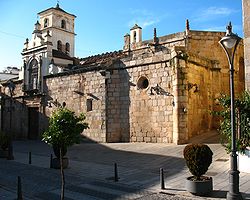- Co-cathedral of Saint Mary Major of Mérida
-
Metropolitan co-cathedral of Saint Mary Major
Concatedral metropolitana de San Maria la Mayor (Spanish)Catedral of Mérida
Basic information Location Mérida, Spain Geographic coordinates 38°54′58.8″N 6°20′49.7″W / 38.916333°N 6.347139°WCoordinates: 38°54′58.8″N 6°20′49.7″W / 38.916333°N 6.347139°W Affiliation Roman Catholic Ecclesiastical or organizational status Metropolitan co-cathedral Heritage designation Bien de Interés Cultural Leadership Archbishop Santiago García Website www.catedraldemerida.com Architectural description Architectural type Church Architectural style Gothic, Romanesque Groundbreaking 1239 Completed 1579 Specifications Length 45 metres (148 ft) Width 30 metres (98 ft) The Metropolitan co-cathedral of Saint Mary Major of Mérida (Spanish: Concatedral metropolitana de San Maria la Mayor) is a Roman Catholic cathedral church in Mérida, Extremadura, western Spain. Since 1994, together with the Metropolitan Cathedral of Saint John the Baptist of Badajoz[1], it is the seat of the Archdiocese of Mérida-Badajoz.
History
Mérida was founded in the year 25 BC, with the name of Emerita Augusta, by order of Emperor Augustus, to protect a pass and a bridge over the Guadiana river. The city became one of the most important cities in the Roman empire. After the fall of the Western Roman Empire, during the Visigothic period, the city maintained much of its splendor, especially under the 6th century domination of the bishops of Emerita, when it was the capital of Hispania. The see of the bishopric of Emerita was "Church of Saint Mary of Jerusalem" (Spanish: Santa María de Ierusalem).
In 713 Mérida was conquered by the Muslim army under Musa bin Nusair but it is not until February, 28, 1119 that the metropolitan see of the Bishops of Emerita was transferred to Santiago de Compostela by the bull of Pope Calixtus II.[1]
The city returned under Christians hands in 1230, when it was conquered by Alfonso IX of León. The city was attached to the Archdiocese of Santiago de Compostela. The construction began on a chapel dedicated to Virgin Mary on the ruins of the visigothic cathedral.
In 1479, Don Alonso de Cárdenas, Master of the Order of Santiago, ordered the extension of the chapel with the intention to make it the main church of the city.[1] In 1620, a bull of Pope Paul V creates the title of titular bishop of Mérida. The bishop was chosen among the priests of the Order of Santiago, that chose the church of Santa María as see of their bishopric.
On July 28, 1994, Pope John Paul II established the Archdiocese of Mérida-Badajoz, making the Church of Saint John Baptist his metropolitan cathedral and co-cathedral the church of Saint Mary Major of Mérida.[2]
Notes
- ^ a b c Official website of the co-cathedral of Mérida
- ^ Pope John Paul II (28 July 1994), "Constitutiones Apostolicae - Emeritensis Augustana" (in Latin), Acta Apostolicae Sedis (Vatican: Congregation for Bishops) 86: 936–937, http://www.vatican.va/archive/aas/documents/AAS%2086%20%5B1994%5D%20-%20ocr.pdf.
References
- Pope John Paul II (28 July 1994), "Constitutiones Apostolicae - Emeritensis Augustana-Pacensis" (in Latin), Acta Apostolicae Sedis (Vatican: Congregation for Bishops) 86: 936–937, http://www.vatican.va/archive/aas/documents/AAS%2086%20%5B1994%5D%20-%20ocr.pdf, "Nova constituitur in Hispania Provincia ecclesiastica Emeritensis Augustana - Pacensis et Sedes ad Metropolitanae Ecclesiae statum attollitur".
Categories:- Cathedrals in Spain
- Churches in Extremadura
- 13th-century architecture
- Gothic architecture in Spain
- Spain stubs
- Architecture stubs
Wikimedia Foundation. 2010.

